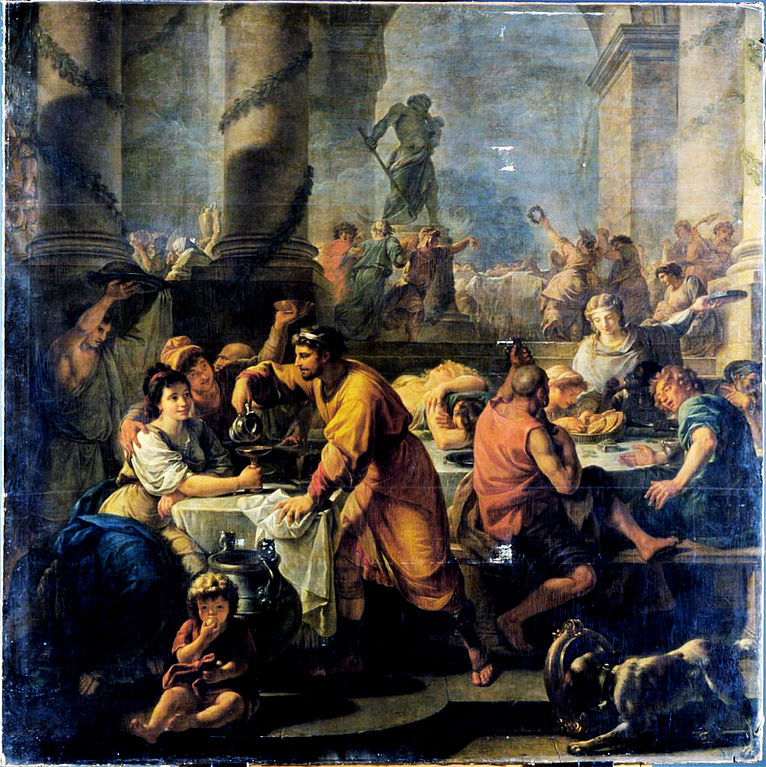Saturnalia
Saturnalia was an ancient Roman festival and holiday in honour of the god Saturn, held on 17 December of the Julian calendar and later expanded with festivities through to 23 December. The holiday was celebrated with a sacrifice at the Temple of Saturn, in the Roman Forum, and a public banquet, followed by private gift-giving, continual partying, and a carnival atmosphere that overturned Roman social norms: gambling was permitted, and masters provided table service for their slaves as it was seen as a time of liberty for both slaves and freedmen alike.
A common custom was the election of a "King of the Saturnalia," who would give orders to people, which were to be followed and preside over the merrymaking. The gifts exchanged were usually gag gifts or small figurines made of wax or pottery known as sigillaria.
The poet Catullus called it: "the best of days."
Origins
In Roman mythology, Saturn was an agricultural deity who was said to have reigned over the world in the Golden Age, when humans enjoyed the spontaneous bounty of the earth without labour in a state of innocence.
The revelries of Saturnalia were supposed to reflect the conditions of the lost mythical age. The Greek equivalent was the Kronia, which was celebrated on the twelfth day of the month of Hekatombaion, which occurred from around mid-July to mid-August on the Attic calendar. The Greek writer Athenaeus also cites numerous other examples of similar festivals celebrated throughout the Greco-Roman world, including the Cretan festival of Hermaia in honor of Hermes, an unnamed festival from Troezen in honor of Poseidon, the Thessalian festival of Peloria in honor of Zeus Pelorios, and an unnamed festival from Babylon. He also mentions that the custom of masters dining with their slaves was associated with the Athenian festival of Anthesteria and the Spartan festival of Hyacinthia.
The Argive festival of Hybristica, though not directly related to the Saturnalia, involved a similar reversal of roles in which women would dress as men and men would dress as women.
Although probably the best-known Roman holiday, Saturnalia as a whole is not described from beginning to end in any single ancient source. Modern understanding of the festival is pieced together from several accounts dealing with various aspects. The Saturnalia was the dramatic setting of the multivolume work of that name by Macrobius, a Latin writer from late antiquity who is the major source for information about the holiday. Macrobius describes the reign of Justinus' "king Saturn" as "a time of great happiness, both on account of the universal plenty that prevailed and because as yet there was no division into bond and free – as one may gather from the complete license enjoyed by slaves at the Saturnalia." In Lucian's Saturnalia it is Chronos himself who proclaims a "festive season, when 'tis lawful to be drunken, and slaves have license to revile their lords".
Human sacrifice
Saturn also had a less benevolent aspect. One of his consorts was Lua, sometimes called Lua Saturni ("Saturn's Lua") and identified with Lua Mater, "Mother Destruction", a goddess in whose honor the weapons of enemies killed in war were burned, perhaps in expiation. Saturn's chthonic nature connected him to the underworld and its ruler Dis Pater, the Roman equivalent of Greek Plouton (Pluto in Latin) who was also a god of hidden wealth. In sources of the third century AD and later, Saturn is recorded as receiving dead gladiators as offerings (munera) during or near the Saturnalia. These gladiatorial events, ten days in all throughout December, were presented mainly by the quaestors and sponsored with funds from the treasury of Saturn.
The practice of gladiator munera was criticized by Christian apologists as a form of human sacrifice. Although there is no evidence of this practice during the Republic, the offering of gladiators led to later theories that the primeval Saturn had demanded human victims.
Macrobius says that Dis Pater was placated with human heads and Saturn with sacrificial victims consisting of men (virorum victimis). During the visit of Hercules to Italy, the civilizing demigod insisted that the practice be halted and the ritual reinterpreted. Instead of heads to Dis Pater, the Romans were to offer effigies or masks (oscilla); a mask appears in the representation of Saturnalia in the Calendar of Filocalus. Since the Greek word phota meant both 'man' and 'lights', candles were a substitute offering to Saturn for the light of life. The figurines that were exchanged as gifts (sigillaria) may also have represented token substitutes.
